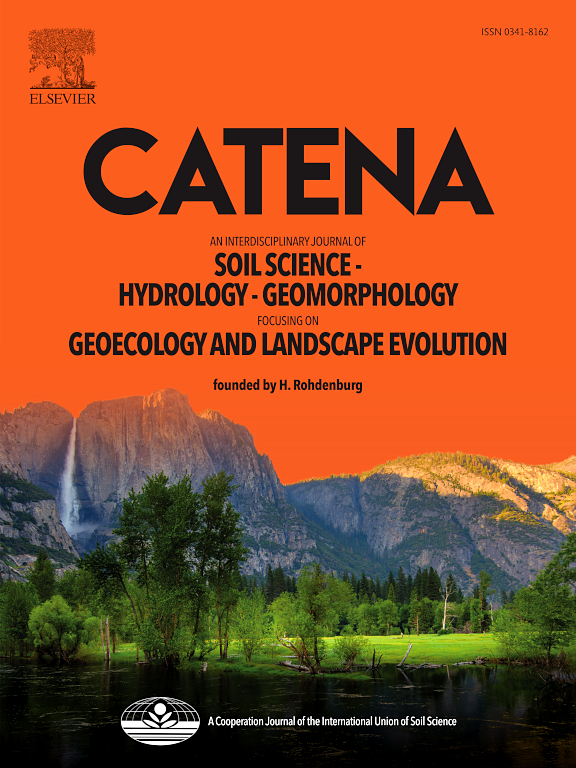A multiproxy comparison study on the source apportionment of organic matter in core sediments in the East China Sea
IF 5.7
1区 农林科学
Q1 GEOSCIENCES, MULTIDISCIPLINARY
引用次数: 0
Abstract
The contributions from various sources and temporal variations of sedimentary organic matter (OM) in marginal seas are not fully understood due to highly dynamic hydrodynamic conditions and discrepancies among different source indicators. This study conducted a multiproxy analysis based on biomarkers and bulk δ13C values to apportion and estimate OM sources in core sediments from the Min-Zhe muddy area of the East China Sea. The goal is to precisely determine the sources and contributions of sedimentary OM, thereby providing new insights into constraining their temporal variations in this highly dynamic region. Multiple biomarkers consistently demonstrate a significant contribution from terrestrial organic matter (TOM). Pearson’s correlation analysis further indicates that long-chain n-alkanols are reasonable biomarkers for tracing TOM, while long-chain n-alkanes reflect the input of other sources. The terrestrial to marine biomarker ratios (TMBR and TMBRol) and a binary mixing model with different δ13C end-members indicate that TOM is the dominant component. Variations in these contributions can reach up to 18 % and 29 % due to δ13C end-member differences and biomarker variations, respectively. Factors affecting these variations include biomarker stability, multiple sources of long-chain n-alkanes, and δ13C end-member differences. Despite inherent variability in precise numerical data, the broadly consistent temporal trends of TOM contributions, as inferred from δ13C mixing models and TMBRol, indicate that these proxies can be effectively used to reconstruct their temporal records. However, more efforts are still needed to accurately determine the contributions of different sedimentary OM sources, particularly to constrain the reasonable δ13C end-member values.

东海岩心沉积物有机质来源的多指标对比研究
由于高度动态的水动力条件和不同来源指标之间的差异,人们对边缘海各种来源的贡献和沉积有机质(OM)的时间变化尚未完全了解。利用生物标志物和整体δ13C值等多指标分析方法,对东海闽浙泥质区岩心沉积物中OM源进行了划分和估算。目标是精确地确定沉积有机质的来源和贡献,从而为在这个高度动态的地区限制它们的时间变化提供新的见解。多种生物标志物一致表明陆生有机质(TOM)的显著贡献。Pearson相关分析进一步表明,长链正烷醇是追踪TOM的合理生物标志物,而长链正烷则反映了其他来源的输入。陆海生物标志物比值(TMBR和TMBRol)和具有不同δ13C端元的二元混合模型表明TOM是主要成分。由于δ13C端元差异和生物标志物差异,这些贡献的差异可分别达到18%和29%。影响这些变化的因素包括生物标志物的稳定性、长链正构烷烃的多种来源以及δ13C端元的差异。尽管精确数值数据存在固有的变变性,但从δ13C混合模式和TMBRol推断的TOM贡献的大致一致的时间趋势表明,这些代理可以有效地用于重建它们的时间记录。然而,要准确确定不同沉积OM源的贡献,特别是限制合理的δ13C端元值,还需要做更多的工作。
本文章由计算机程序翻译,如有差异,请以英文原文为准。
求助全文
约1分钟内获得全文
求助全文
来源期刊

Catena
环境科学-地球科学综合
CiteScore
10.50
自引率
9.70%
发文量
816
审稿时长
54 days
期刊介绍:
Catena publishes papers describing original field and laboratory investigations and reviews on geoecology and landscape evolution with emphasis on interdisciplinary aspects of soil science, hydrology and geomorphology. It aims to disseminate new knowledge and foster better understanding of the physical environment, of evolutionary sequences that have resulted in past and current landscapes, and of the natural processes that are likely to determine the fate of our terrestrial environment.
Papers within any one of the above topics are welcome provided they are of sufficiently wide interest and relevance.
 求助内容:
求助内容: 应助结果提醒方式:
应助结果提醒方式:


